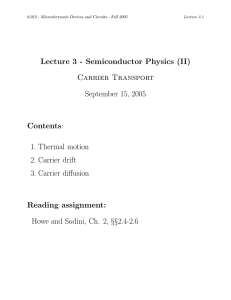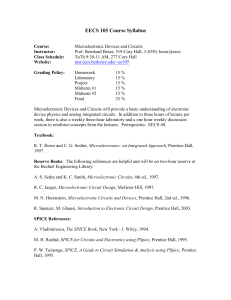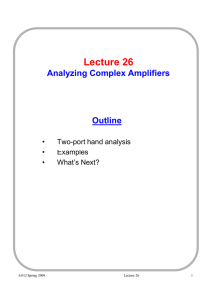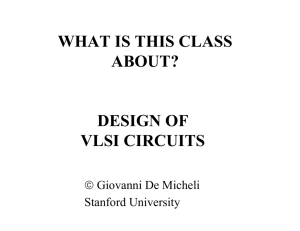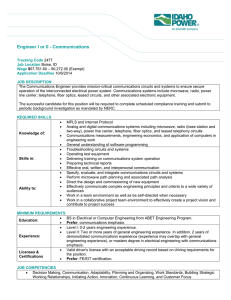Lecture 3 - Semiconductor Physics (II) Contents Reading assignment: Carrier Transport
advertisement
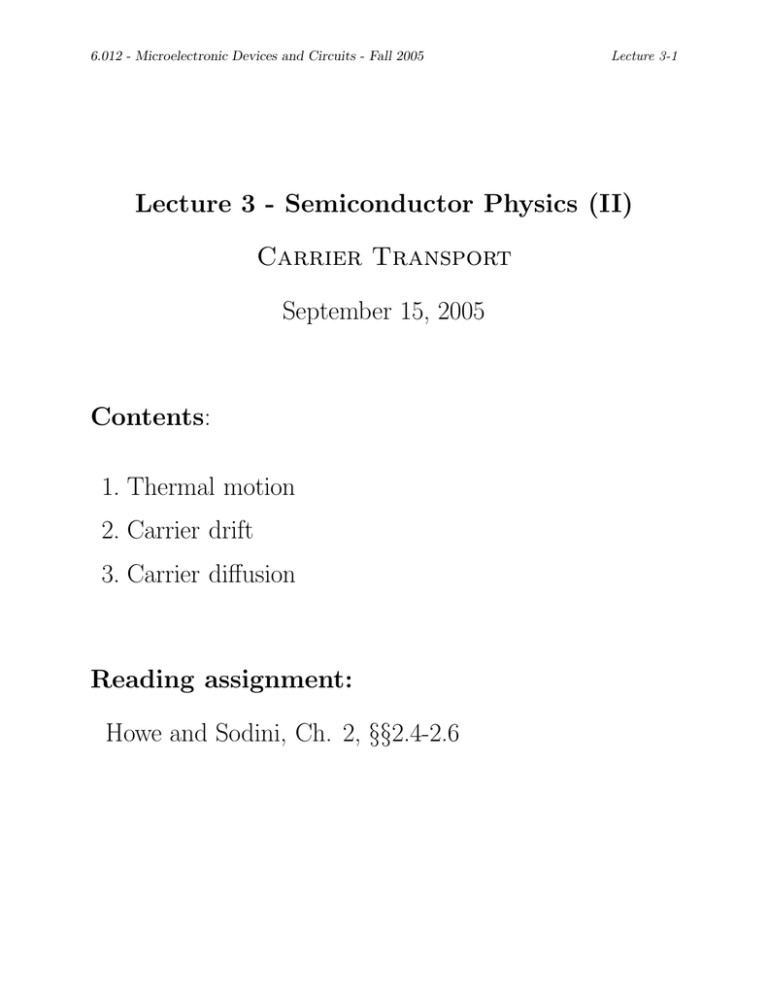
6.012 - Microelectronic Devices and Circuits - Fall 2005 Lecture 3-1 Lecture 3 - Semiconductor Physics (II) Carrier Transport September 15, 2005 Contents: 1. Thermal motion 2. Carrier drift 3. Carrier diffusion Reading assignment: Howe and Sodini, Ch. 2, §§2.4-2.6 6.012 - Microelectronic Devices and Circuits - Fall 2005 Lecture 3-2 Key questions • What are the physical mechanisms responsible for current flow in semiconductors? • How do electrons and holes in a semiconductor behave in an electric field? • How do electrons and holes in a semiconductor behave if their concentration is non-uniform in space? 6.012 - Microelectronic Devices and Circuits - Fall 2005 Lecture 3-3 1. Thermal Motion In thermal equilibrium, carriers are not sitting still: • undergo collisions with vibrating Si atoms (Brownian motion) • electrostatically interact with charged dopants and with each other Characteristic time constant of thermal motion - mean free time between collisions: τc ≡ collision time [s] In between collisions, carriers acquire high velocity: vth ≡ thermal velocity [cm/s] ...but get nowhere! 6.012 - Microelectronic Devices and Circuits - Fall 2005 Lecture 3-4 Characteristic length of thermal motion: λ ≡ mean free path [cm] λ = vthτc Put numbers for Si at 300 K: τc ' 10−14 ∼ 10−13 s vth ' 107 cm/s ⇒ λ ' 1 ∼ 10 nm For reference, state-of-the-art MOSFETs today: Lg ' 50 nm ⇒ carriers undergo many collisions in modern devices 6.012 - Microelectronic Devices and Circuits - Fall 2005 Lecture 3-5 2. Carrier Drift Apply electric field to semiconductor: E ≡ electric field [V /cm] ⇒ net force on carrier F = ±qE E - Between collisions, carriers accelerate in direction of field: qE v(t) = at = − m t n v(t) = qE t mp for electrons for holes 6.012 - Microelectronic Devices and Circuits - Fall 2005 Lecture 3-6 But velocity randomized every τc (on average): net velocity in direction of field τc average net velocity time Then, average net velocity in direction of field: qE qτc v = vd = ± τc = ± E 2mn,p 2mn,p This is called drift velocity [cm/s]. Define: µn,p = qτc 2mn,p ≡ mobility [cm2 /V · s] Then, for electrons: vdn = −µnE for holes: vdp = µp E 6.012 - Microelectronic Devices and Circuits - Fall 2005 Lecture 3-7 Mobility is measure of ease of carrier drift: • if τc ↑, longer time between collisions → µ ↑ • if m ↓, ”lighter” particle → µ ↑ Mobility depends on doping. For Si at 300K: 1400 1200 electrons mobility (cm2/Vs) 1000 800 600 holes 400 200 0 1013 1014 1015 1016 1017 1018 Nd + Na total dopant concentration (cm−3) 1019 1020 • for low doping level, µ limited by collisions with lattice • for medium and high doping level, µ limited by collisions with ionized impurities • holes ”heavier” than electrons: → for same doping level, µn > µp 6.012 - Microelectronic Devices and Circuits - Fall 2005 Lecture 3-8 Drift current Net velocity of charged particles ⇒ electric current: Drift current density ∝ carrier drift velocity ∝ carrier concentration ∝ carrier charge Drift currents: Jndrift = −qnvdn = qnµn E Jpdrift = qpvdp = qpµp E Check signs: E vdn E vdp - + Jpdrift Jndrift x x 6.012 - Microelectronic Devices and Circuits - Fall 2005 Lecture 3-9 Total drift current: J drift = Jndrift + Jpdrift = q(nµn + pµp )E Has the shape of Ohm’s Law: J = σE = E ρ Where: σ ≡ conductivity [Ω−1 · cm−1 ] ρ ≡ resistiviy [Ω · cm] Then: ρ= 1 1 = σ q(nµn + pµp ) 6.012 - Microelectronic Devices and Circuits - Fall 2005 Lecture 3-10 Resistivity commonly used to specify doping level. • In n-type semiconductor: ρn ' 1 qNdµn • In p-type semiconductor: 1 ρp ' qNaµp For Si at 300K: 1E+4 1E+3 Resistivity (ohm.cm) 1E+2 1E+1 p-Si 1E+0 n-Si 1E-1 1E-2 1E-3 1E-4 1E+12 1E+13 1E+14 1E+15 1E+16 1E+17 1E+18 1E+19 1E+20 1E+21 Doping (cm-3) 6.012 - Microelectronic Devices and Circuits - Fall 2005 Numerical example: • Si with Nd = 3 × 1016 cm−3 at 300 K µn ' 1000 cm2/V · s ρn ' 0.21 Ω · cm • apply |E| = 1 kV /cm |vdn| ' 106 cm/s vth |Jndrift | ' 4.8 × 103 A/cm2 • time to drift through L = 0.1 µm: td = fast! L = 10 ps vdn Lecture 3-11 6.012 - Microelectronic Devices and Circuits - Fall 2005 Lecture 3-12 3. Carrier diffusion Diffusion: particle movement in response to concentration gradient. n x Elements of diffusion: • a medium (Si crystal) • a gradient of particles (electrons and holes) inside the medium • collisions between particles and medium send particles off in random directions: → overall, particle movement down the gradient 6.012 - Microelectronic Devices and Circuits - Fall 2005 Lecture 3-13 Key diffusion relationship (Fick’s first law): Diffusion flux ∝ - concentration gradient Flux ≡ number of particles crossing unit area per unit time [cm−2 · s−1] For electrons: dn Fn = −Dn dx For holes: Fp = −Dp dp dx Dn ≡ electron diffusion coefficient [cm2 /s] Dp ≡ hole diffusion coefficient [cm2 /s] D measures the ease of carrier diffusion in response to a concentration gradient: D ↑ ⇒ F diff ↑. D limited by vibrating lattice atoms and ionized dopants 6.012 - Microelectronic Devices and Circuits - Fall 2005 Lecture 3-14 Diffusion current density = charge × carrier flux Jndiff = qDn dn dx Jpdiff = −qDp dp dx Check signs: n p Fn Fp Jpdiff Jndiff x x 6.012 - Microelectronic Devices and Circuits - Fall 2005 Lecture 3-15 Einstein relation At the core of diffusion and drift is same physics: collisions among particles and medium atoms ⇒ there should be a relationship between D and µ Einstein relation [don’t derive in 6.012]: D kT = µ q In semiconductors: Dn Dp kT = = µn µp q kT q ≡ thermal voltage [V ] At 300 K: kT ' 25 mV q For example: for Nd = 3 × 1016 cm−3 : µn ' 1000 cm2/V · s → Dn ' 25 cm2/s µp ' 400 cm2/V · s → Dp ' 10 cm2 /s 6.012 - Microelectronic Devices and Circuits - Fall 2005 Lecture 3-16 Total current In general, current can flow by drift and diffusion separately. Total current: Jn = Jndrift + Jndiff = qnµn E + qDn Jp = Jpdrift + Jpdiff = qpµp E − qDp And Jtotal = Jn + Jp dn dx dp dx 6.012 - Microelectronic Devices and Circuits - Fall 2005 Lecture 3-17 Summary: relationship between v, F , and J In semiconductors: charged particles move ⇒ particle flux ⇒ electrical current density Particle flux: number of particles that cross surface of unit area placed normal to particle flow every unit time Fn vn dt Relationship between particle flux and velocity: Fn = nvn Fp = pvp Current density: amount of charge that crosses surface of unit area placed normal to particle flow every unit time Jn = −qFn = −qnvn Jp = qFp = qpvp whether carriers move by drift or diffusion. 6.012 - Microelectronic Devices and Circuits - Fall 2005 Lecture 3-18 Key conclusions • Electrons and holes in semiconductors are mobile and charged ⇒ carriers of electrical current! • Drift current: produced by electric field J drift ∝ E • Diffusion current: produced by concentration gradient J diff ∝ dn dp , dx dx • Carriers move fast in response to fields and gradients • Diffusion and drift currents are sizable in modern devices

